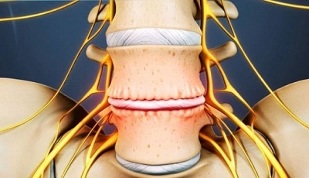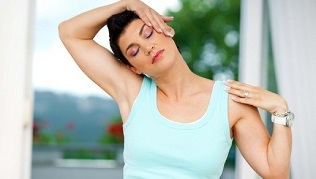Timely treatment of the disease can increase the chances of a quick and successful recovery. However, it is better to prevent the development of diseases, especially serious ones such as cervical osteochondrosis.
Definition of cervical osteochondrosis

Cervical osteochondrosis is a relatively common disease that has recently struck young people. The disease affects the intervertebral disc in the cervical spine. Often, the development of pathological processes of degenerative-dystrophic changes is facilitated by incorrect body position, for example, due to long work on the computer.
Among other things, the problem can be triggered by genetic predisposition, poor posture, uncomfortable sleeping and inactive lifestyle. Although this type of osteochondrosis develops relatively slowly, it tends to develop.
In elderly patients, this disease is mainly combined with other degenerative processes, for example:
- interspinous arthrosis;
- spondylosis;
- uncovertebral arthrosis and so on.
Symptoms
Regarding the most typical symptoms, first of all, one can see the appearance of acute pain arising from pinching the nerve endings. Pain is often concentrated in the lumbar, cervical and back areas. In addition, you can find other syndromes:
- heart syndrome- consists of several symptoms similar in manifestation to angina pectoris. This syndrome develops during irritation of the pectoralis major muscle root or phrenic nerve. As a result, a person experiences a painful sensation from stress in the area of the heart muscle, which can periodically arise and persist for several hours. Sneezing or sudden movement of the head often makes the pain worse. Moreover, during a painful attack, no changes in the cardiogram can be detected;
- radicular syndrome- occurs when the nerve endings in the cervical spine are pinched. At this time, pain is felt, which can be given not only to the forearms, shoulders or shoulder blades, but also to the lumbar region. Patients may experience mild tingling or more pronounced sensations, depending on how much osteochondrosis begins;
- irritation-reflex syndrome- manifested by a burning sensation in the occiput and neck. Such symptoms often appear after waking up, during sharp head rotations, coughing and sneezing. Moreover, the pain can manifest itself not only in the shoulder area, but also in the chest area;
- vertebral artery syndromeis one of the typical manifestations of this disease, characterized by the occurrence of burning or throbbing headaches, which are more localized in the temporal or occipital area. Often with this syndrome, constant pain occurs, but sometimes it can arise and subside.
Watch out!If there are symptoms of cervical osteochondrosis, experts suggest an increase in fatigue, which can lead to hearing and vision disorders.

As for the main symptoms of this disease, these include:
- Compression of blood vessels, which causes an increase in blood pressure;
- severe headache that occurs due to impaired blood circulation in the brain. Pain like this can cause patients to constantly use painkillers;
- vision and hearing problems;
- pain, a relatively severe pain in the neck and shoulders, which can sometimes be exacerbated by a sharp and very unpleasant "lumbago";
- grind and crack when tilting head or turning sideways;
- decreased muscle strength in the arm due to pain in the chest;
- dizzy.
Important!Once the first symptoms of the disease are observed, it is necessary to immediately seek help from a neurologist.
Reason
The main causes of osteochondrosis are as follows:
- Metabolic disorders that negatively affect the normal state of cartilage in the intervertebral disc.
- Mobility of the cervical vertebrae is insufficient, as there is fluid loss, which in turn, has a negative impact on cartilage elasticity.
- Microtrauma of the cervical spine, during head tilt, rotation, and so on.
- Weak descent, because disk security margins are very small.
Treatment
The therapeutic process directly depends on the stage of the disease and is based on an integrated approach. On average, treatment lasts from 1 to 3 months, after which it is necessary to support the elimination of symptoms with preventive measures for about 1 more year.
Primary treatment is performed in 2 directions, depending on the patient's state of health and the degree of neglect of the disease. For conservative treatment, this includes taking medication and exercising. Surgical treatment is only performed if conservatives do not have an effect.
It is importantto follow a diet and make sure you follow the recommendations on therapeutic exercises.
Conservative treatment aims to relieve pain, restore and normalize spinal function, and prevent adverse changes. In such therapy, various methods of therapy are used:

- spinal traction (traction). With the use of special medical equipment, the spine is stretched to increase the distance between the vertebrae;
- drug therapy. The use of drugs during the disease is aimed primarily at relieving pain, relieving inflammation and normalizing metabolic processes in the body;
- physiotherapy. Thanks to such a procedure, it is possible not only to reduce the pain, but also to increase the effect of taking the drug. Such methods are also used during the recovery period. In this case, laser beams, ultrasonic waves, low frequency currents, working with magnetic fields, etc. are often used;
- kinesitherapyand exercise-based exercise therapy;
- manual therapy. Such treatments are selected individually for each patient;
- urut. Thanks to massage, you can speed up blood circulation in tissues, eliminate clamps and muscle cramps, in general, increase blood supply to tissues throughout the body.
Although medication alone cannot cure osteochondrosis, it can help restore tissue blood supply. Therapy should be comprehensive, only in this case we can discuss the effectiveness of treatment. In addition to taking medication, it is very important to undergo physical therapy, follow a diet, and abandon bad habits.
If there is no significant pain or dystrophy changes, taking medication without a doctor's prescription is not appropriate. The following types of drugs are used to treat this disease and relieve pain:
- means for regrowth, as well as for the prevention of degeneration of cartilage tissue: hyaluronic acid and its analogues;
- to relieve inflammation;
- preparations to increase blood supply to tissues: vitamin B;
- antispasmodik;
- antioxidants: vitamins N, E and C.

Medicines can be prescribed not only as tablets and capsules for oral administration, but also as injections or topical ointments / creams. If there are acute complications, medication is used to block the nerve endings.
Along with drug therapy, it is very important to maintain a healthy lifestyle and proper nutrition. Drink at least 1. 5 liters of water a day.
One and a half liters of water a day is the recommended norm for joint and whole body health.
Naturally, you can also use herbal teas, fruit drinks, dried fruit compote or mineral water. Coffee, strong black tea, alcohol and carbonated beverages should be eliminated from the daily diet.
Prevention
The main causes of osteochondrosis are neglecting the needs of the body, heavy load and improper nutrition. That is why prevention should be based on the complete elimination of negative effects on the spine and prevention of the onset of pathological changes. For this purpose, simply adhere to the usual rules of healthy lifestyle (healthy lifestyle):
- only moderate physical activity during sports: morning exercise, gymnastics, athletics, if wrestling type, if not contact, swimming is an excellent choice;
- if staying long in one position, for example, when not working, it is very important to rest, at least once every 45-60 minutes. During this period, you need to give the body 5-15 minutes for a slight warm-up, which will restore normal blood circulation. Also, it is very important to pay attention to the right choice of office chair or armchair, give priority to those who support the spine, control the correct position of the hands on the table and feet on the floor. Try to monitor your posture freely (your shoulders should be in a relaxed position and your back should be straight);
- It is important to try to control your emotions in the event of a spasmodic reaction during stress. For this purpose, you need to learn relaxation techniques and attend a systematic sequence for body strengthening in general;
- For sleep, it is better to choose an orthopedic mattress with a flat surface. Of course, it will not be as soft as a feather bed, but its elasticity will ensure proper body position;
- drinking plenty of fluids and proper nutrition helps not only to maintain metabolism, but also to strengthen the body as a whole:

Mental conditions also have a negative effect on joint condition.
- if necessary to move or lift heavy objects, it is very important to do it smoothly, without suddenly touching the lungs and jerking from a partial squat position. No need to use special support belts;
- the important thing is the selection of high quality orthopedic shoes without high heels, with sufficient foot width. It is also possible to reduce the load on the spine through timely replacement of worn shoes, which is very important for women. In the summer, in this country, at sea, if possible, you should walk barefoot on different surfaces, thus strengthening the leg muscles.
It is important to rememberthat prevention is much better and easier than the treatment of subsequent diseases.
Exercises
You do not need to do physical activity and exercise without a doctor's prescription or before the pain syndrome subsides. Specialists must first eliminate acute symptoms. If there are symptoms of pain, gymnastics will be painful.
There are some very effective and simple exercises. It can be done not only at home, but also anywhere, including at work or on the road.
When starting to exercise, in all cases the initial posture is sitting on a chair, hands folded at the knees:
Need to start with heating:
- At the starting position, you need to slowly turn your head to one side until it stops, and then to the other. At this point, you need to feel how the neck muscles stretch. Once the neck is rotated to one side along the way, you need to rotate it a few more degrees as carefully as possible, avoiding sudden movements and fixing it in this condition for 5 seconds. Experts recommend starting exercise with warm-up to strengthen the neck muscles. In each direction, it is enough to do 5 rotations to develop the strength and flexibility of the neck.
- Next, you need to tilt your head so that your ears are close to your shoulders. Keep in mind that at this stage, the shoulder must not move. At maximum approach, you need to improve the position. Be careful to make sure that the action does not cause discomfort or pain. Enough to do such a tendency 5 times for each side.

Next, move on to the main exercises:
- Now that the warm-up is over, you can move on to specific exercises that can give good results. In the starting position, you need to place your hand on the right temple. Now you need to tilt your head to the right, and your hands at this point should prevent it. The effort should be heavy, but his head is slowly tilted in this direction. For each side, 10 slopes will suffice. Naturally, hands also need to be replaced.
- Next, you need to grip the occipital area of the head, and create endurance, trying to tilt the head back 5 times.
- The same exercise must be done if placing the palm on the forehead. Through endurance, you need to pull the chin to the chest. Enough for 5 turns forward.
- The conclusion from the exercise can be trap warming, which is done by lowering and lifting the shoulders. At the highest point, you need to lock for a few seconds, then lower and rest completely. Enough for 10 repetitions.
- Complete the exercise by stretching the neck in different directions. This set of exercises must be done daily. This is a great option for warming the neck with osteochondrosis.
In addition to strength training, neck flexion exercises can be included. They will help not only strengthen the neck muscles, but also the tendons. Warming up will make your neck move more easily.
This exercise is recommended by experts not only for osteochondrosis of the cervical spine, but also for everyone over 30 years of age. The problem is that at this age, muscle fibers lose their flexibility, so it is important to maintain them, along with the overall health of the body.
- The chin must be pulled to the chest and at this point help the head with your hands.
- Be very careful, with your hands you have to tilt your head to the side to touch your shoulders with your ears.
Only proper treatment of the first symptoms of osteochondrosis allows you to overcome this problem as soon as possible and return to normal life, without pain and discomfort.
Next, you need to do some circular movements of the head in one direction and then in the other. Just 8 turns for each side. Exercise must be done very carefully. For safety reasons, you can hold the head with your hands.

















































